Found on Dalmatia’s most southerly isle sits the mostly untouched and lushly covered island of Mljet. If you’re ready to leave the busyness of your life behind and relax without the constant pressures of city life, Mljet is an Adriatic oasis getaway.
Settled off the coast of the Peljesac Peninsula, Mljet is most commonly known for its National Park which covers around one third of the island. Sparsely inhabited and virtually car-free, Mljet’s petite population really comes alive during the summer; but given that two-thirds of Mljet are covered in verdant forest, tranquil spots are still a dime a dozen for those seeking peace and serenity.
Mljet may be overlooked by travellers purely based on its location, being the most southerly island, but its captivating beauty must be seen to be believed. Mljet has enchanted even the likes of the British Monarchy - Prince Charles has frequented twice himself!
History of Mljet
This emerald green paradise has a long and eventful history coming in and out of many authorities. Mljet’s history can be traced back some 4,000 years to the Illyrians, whose archeological remains were discovered in the channel where they are believed to have been pirating. It is the ancient Romans however, that are primarily accredited with the discovery of this island. Mljet came under Roman rule in 167BC, initially scribing this natural wonderland as ‘Melite/Melita’, deriving from the ancient Greek word for honey. It is believed that Mljet was once covered in an abundance of bee colonies!
Despite being under the rule of the Romans, Mljet wasn’t exploited much by the empire until the 3rd century, when they built a palace for the Roman governor that was then used as a defence structure for Mljet.
Eventually, the Romans lost their rule to the Benedictines in the 12th century by the order of the Pope, who became masters of the whole island. Up until the 14th century, Mljet was ruled under the dominion of the Republic of Ragusa (Dubrovnik) and by the 19th century, Mljet was passed around between France, England, Austria, Yugoslavia and finally to Croatia.
An ecological cataclysm occurred on the island in the early 20th century. Mljet was once home to a profuse amount of poisonous snakes which the monks were not fans of. As legend also has it, St. Paul the Apostle who was deemed to have shipwrecked in Mljet, was injured by these poisonous snakes because there were so many. By the early 20th century, after years of frustration, the monks decided to address this issue head on and introduced a colony of Indian Mongoose to the island - who just happened to be a natural predator to the snakes. This completely eradicated the snakes on the island, although the mongoose then shifted its attention to native birds and chickens, with not much that could be done as there is no natural predator to the mongoose on the island!
In the later half of the 20th century, Mljet’s esteemed National Park title was inducted and this paved the way for the island to emerge as a tourist destination for travellers near and far.
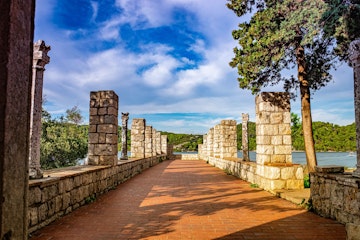
The Best Way to Get to Mljet
Given its location, getting to Mljet isn’t as easy as its mainland cousins, however it is definitely still feasible. There are no airports on the island but there are a number of ferry and catamaran lines connecting travellers to Mljet. Both Split and Dubrovnik are well connected to Mljet, so for international travellers, flying into either of these cities will be your best option.
The closest mainland port is Dubrovnik. There are regular ferry connections from here and the journey is roughly 1 hour and 20 minutes. The ferry will dock in the port of Pomena which is on the same side as the National Park.
In addition to the ferry, there are various catamaran options available from both Split and Korčula. Connections from Korčula take only 30 minutes, however, from Split, the journey will take around 3 hours. You can find the ferry timetable to Mljet here.
If you’re joining us on a Sail Croatia cruise, Mljet is most likely a destination on your itinerary!

Things to Do in Mljet
Shrouded in folk history, ancient culture and, of course, a natural haven, Mljet actively compels visitors to explore as much of its evergreen estate as they can!
- Visit the National Park
As one of 8 national parks in Croatia, and the most untouched of them all, Mljet’s National Park goes hand-in-hand when visiting this island.
Pack a backpack and start walking in any direction you like! The admittance fee to the National Park is between €15 - €25 and tickets can be purchased in Pomena before you enter the National Park or at the ticket office located just inside the National Park. Once inside, there are a myriad of activities on offer; however taking a moment to appreciate the pristine and unchanged nature of the park is something worth doing.
Officially a protected natural sanctuary, the National Park can be visited all year round although we recommend a summer affair so you can swim in the wonderfully warm waters! Little, picturesque villages dot the National Park and they are also protected structures. The most notable village, Goveđari, is a small settlement that gets its name from the word ‘govedo’, meaning cattle. It was established by the Benedictines during their rule of the island and was populated with mainlanders who were allowed to work and live in the village, provided they paid homage to the monastery. Today, Goveđari is uninhabited and completely restored to its previous glory and can be admired by visitors.
Brimming with 5 different varieties of trees, inhale the pure freshness the park offers as you meander your way through the Aleppo pines!

- Kayak in Mljet
Spend your time gliding along the coastline at your leisure by kayak! Sheltered from the National Park, the waters are graciously calm which make for great kayaking and an even better way to see the park coastline. Perfect for any and all travellers given the calmness of the lake, you’ll be struck with the beauty of the island's waters. From crystal clear turquoise to chartreuse, these colours must be seen to be believed. The easiest location to rent a kayak is from Mali Most, where the two famous Mljet lakes are joined by a narrow channel. Hiring a 2-person kayak will cost you anywhere from €25-30 for the day.
If you’re up for the adventure, you can kayak your way over to St. Mary’s island as well, famously known as the island within an island. This will take you around half an hour and once you’ve arrived, take some time to cool down with a refreshing drink at the monastery restaurant before making your way back.
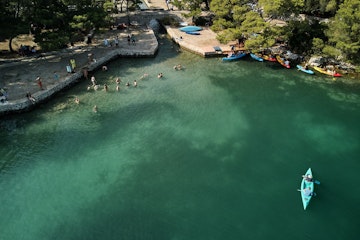
- Explore the Island by Bike
Cars are few and far between on Mljet and the best way to explore the island is by bike. For the more experienced bike riders, cycling around the whole island is an opportunity to see the beauty of the island, although it may take you a little while - especially if you make stops along the way! Most bike riders choose to cycle within the National Park as the only other traffic is fellow cyclists and pedestrians. The terrain suits all levels of riders so you can expect a nice, pleasant ride through the forest without getting too tired. Coast along the gravel paths surrounding the large lake for picturesque views and, if you’ve brought your swimmers (which we definitely recommend), park up near the water's edge for a refreshing dip. If you’re looking to trail around the large lake, the distance is around 1450m2 (9km return), versus the small lake’s 250m2.
This is by far the best and most scenic way to explore this untamed island and discover all its hidden crevices and forest groves.
Bike rental costs €15 per hour, and allows you to enjoy the entire day saddled up. If you’re joining us on a Sail Croatia cruise, you’re also able to enjoy a discounted bike hire!

- Take a Boat to St. Mary’s Island
If you’re at Veliko Jezero, you will definitely catch a glimpse of the famous island within an island; St. Mary’s! St. Mary’s holds an exorbitant amount of history which can be explored once you set foot on the islet. From the monastery, chapels, untouched forest and even the resident donkey, Melita, it can all be found in this pin on the map. You may be thinking, how do you get to St. Mary’s, and the answer may surprise you! Whilst you are able to kayak your way over, the other way is to essentially flag down a taxi boat! Everytime someone wants to travel to the islet, you need to wave a flag until it’s seen by the skipper who will then come and collect you to take you over.
National Park entry includes a ticket to the island so all you need to do is wave your flag over to the other side!
- Visit Malo Jezero and Veliko Jezero
As one, or technically two, of Mljet’s enchanting gems, layers of lush forest surround two natural phenomenons - Malo Jezero (Small Lake) and Veliko Jezero (Large Lake). These lakes hold great importance to Mljet because they were once comprised of freshwater, and in a unique geographical and oceanographical turn of events, they both transformed into saltwater lakes. This is thanks to the natural development of the narrow Solinski channel that connects the lakes to the Adriatic Sea.
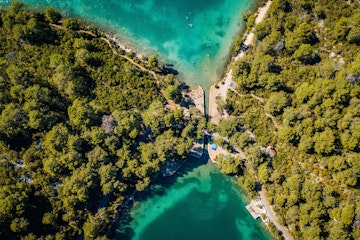
Veliko Jezero
Easily identifiable as the lake that holds the islet of St. Mary’s, Veliko Jezero is prime water for swimming as temperatures are quite warm in the summer, considering there's no other outlets to the sea apart from the Solinski channel. Veliko Jezero is blessed with many nooks and crannies around the shoreline that will make for infinite exploring opportunities - one of which is swimming or kayaking to the islet itself!
One of Veliko Jezero’s top attractions is its thriving coral reef. Thanks to the Adriatic opening allowing for a saltwater ecosystem, an abundance of clams and mussels as big as 2 feet can be discovered whilst snorkelling!
Malo Jezero
Much like Veliko Jezero, the beauty of Malo Jezero is just as overwhelming despite its name. But unlike Veliko, this small lake has water warmer than its neighbour! Where the large lake has its islet, Malo Jezero has a distinguishable bridge aptly named Small Stone Bridge, or Mali Most, which arches between the shorelines - this is also an amazing location for a photo opportunity.

- Float Under Mali Most
Connecting the two shores of the famous lakes by a small channel stands Mali Most, meaning small bridge. This stone bridge is a crowd favourite, not so much for the bridge itself, but for what lies underneath. Due to its design, this small channel experiences strong currents which allows you to float along effortlessly making your way to Veliko Jezero! This is definitely an activity to tick off your bucket list, or float down with your kayak which you can hire right near Malo Jezero.
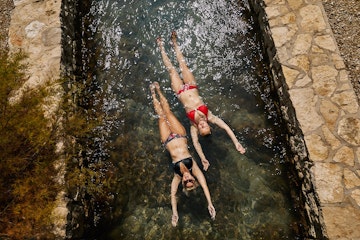
- Catch a Famous Sunset
Untouched greenery, lush forests and beautiful surrounding waters, you can imagine a sunset in Mljet would be nothing short of magical! With a melodious vibe as the island's nature sings for you, and golden hour light dapples through the Aleppo pines, it’s as if Mljet tells you to slow down and appreciate the view, and nothing rings more true than to its sunsets. Choose any point of the island and you’re guaranteed an enchanting sight, although we recommend catching a sunset at the Hotel Odisej for a bewitching experience.
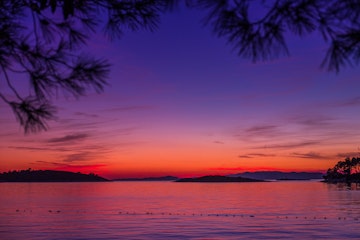
Top Bars in Mljet
If you’re looking for a party destination, then you’ve definitely come to the wrong place! What Mljet lacks in bars and nightlife, it makes up for in natural beauty, incredible sunsets and authentic charm. Despite this relaxed way of life there are still a couple of places that are perfect for enjoying a cocktail with a view!
Hotel Odisej
Right on the Pomena dock where ships and ferries arrive, Hotel Odisej is perched right on the bay and is a world away from the urban life found on the mainland. Hotel Odisej opened tourism in Pomena, as it was the first hotel to be built here and makes it a historically significant location. This is the perfect seaside escape to enjoy a cocktail overlooking panoramic views of the water, which are especially spectacular at sunset.
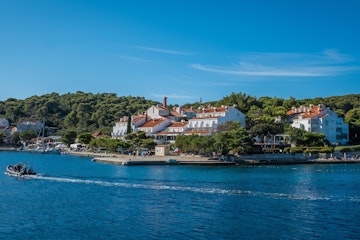
Komarac
Komarac can be found in Mljet’s Babino Polje which is, put simply, in the middle of the island. Komarac literally translates to ‘mosquito’ and just like an itch needing to be scratched, Komarac will satisfy your thirst and after dark needs. During the day Komarac acts as a regular bar serving up coffee for locals and travellers alike, but come nightfall, the mood changes and the music starts. It’s not the overcrowded bar you’ll come across on the mainland, but for Mljet it’s just perfect.
Beach Bar Vista Mare
In the confines of the National Park, Pomena’s Vista Mare Beach Bar sits on the shoreline. The aesthetics are modern and inviting, with lounge chairs overlooking the water, creating a romantic atmosphere come sunset. Enjoy the sun setting over the sea horizon with a strawberry mojito in hand!
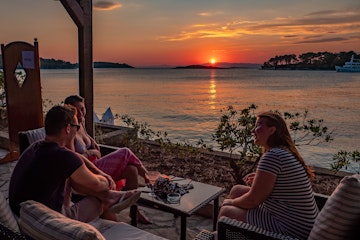
Beach Bar Hippokampos
Unlike the name suggests, the only relevance to exotic wildlife at this beach bar is their wild and extensive cocktail list. Found in Saplunara, this beach bar sits nearly at the most southern point on the island and right on the beach. Sit back, relax, and bask in the sea views whilst devouring a cold drink.
Where to Eat in Mljet
Okuklje Restaurant Maestral
This upper-crust restaurant is in a league of its own serving comforting Croatian food for over 20 years. Now in its 3rd generation, the owner's son, now turned chef, approaches the menu with modern elements whilst still paying homage to tradition. Tantalising produce, from the likes of scorpion fish and muscles from Sobra, are all part of the menu repertoire, but we recommend calling ahead and placing an order for the traditional peka, where you can watch them prepare the meal in the rustic oven first-hand!
Stermasi
Stermasi is a delightful destination for those searching for domestic Dalmatian cuisine. Perched on a hill overlooking Saplunara, and with an ambiance like no other, this Konoba deserves the high praise it receives. The special attention to details are not lost on patrons enjoying a dish, as the restaurant takes great care and pride over their food. Their fresh seafood is highly accredited, particularly the succulent squid and octopus that is paired perfectly with a local wine chosen by the owner.
Our top tip: Pick up one of their speciality bottles of homemade olive oil that’s made on location!

Mali Raj
It’s no surprise that Mali Raj calls itself ‘little paradise’ - found in the heart of the National Park in a tranquil cove by the side of Veliko Jezero, it creates the perfect backdrop to accompany your meal. Family owned and operated, the restaurant procures much of its produce from the Adriatic. If you’re lucky enough to visit at the right time, you may even be accompanied by traditional live music as you enjoy your feast.
Our top tip: Book for dinner at sunset for an incredible view.
Island Attractions in Mljet
Mljet has an ‘old town’ appeal scattered around the island. Since most of the island is uninhabited civilisation, architecture didn’t progress the same way compared to its famous mainland family. However, Mljet is still home to some incredible attractions that may surprise you!
St. Mary’s 12th Century Benedictine Monastery
Famously known as the island within an island, Sveti Marija (St. Mary) is the islet that sits within the confines of Mljet’s Veliki Jezero. The most notable attraction is none other than the 12th century Benedictine Monastery and a church on the south-east part of the island. Both structures are enclosed by stone walls guarded by a defensive tower.
Before the 16th century, this monastery was the centre of congregation for the monasteries involved in the Republic of Ragusa. Despite the scarcely uninhabited population, the island held much prestige! Once Mljet came under the rule of Napoleon in the 19th century, the monastery was dismantled. Today’s St. Mary’s is a beautiful and tranquil islet that’s worth a wander. Much like the beauty from the nearby National Park, there are stunning shady paths and beautiful blooms that surround the land - and many photo opportunities that await! What was once the hub for monks near and far, is now the historical remains for travellers to enjoy. To complete your time on this islet, refresh at the restaurant or cafe that now resides in the monastery! Gaze off into the blue and green abyss before treating yourself to a small keepsake from the souvenir shop closeby.
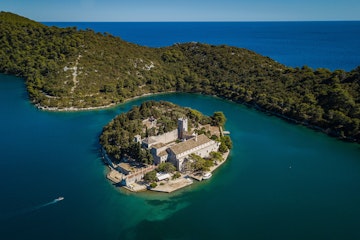
Roman Palace
Nestled on the north-western coast lies one of Mljet’s oldest and historically significant settlements in its namesake village, Polače. Back when the Romans were rulers of Mljet, the Roman Palace, built some time around the 5th century, dominated the coastal bay in what is now one of Dalmatia’s largest and best preserved Roman structures, falling closely behind Split’s Diocletian Palace and Pula’s Arena. The success of the preserved ruins is largely thanks to its location. The Polače bay is both the largest and safest bay in Mljet, sheltered and secluded as a result of 4 surrounding islands offering impressive protection from the natural elements. In its prime, the palace once housed a thermal bath, Christian Basilicas and even an arsenal which places great historical and cultural value on the palatial structure. Exploring the ancient ruins of this once prominent edifice begs you to wonder what life was like during those ancient times.

Odysseus Cave
Veiled in a cliff face on the southern coast of Mljet reigns the mystical and natural phenomenon, Odysseus Cave. Legend has it that the famous Greek Odysseus shipwrecked nearby and found safety in this cave where he soon met and fell in love with the nymph who ruled the land, Calypso - so much so that he stayed for 7 years. There is much to say about the legend, but even to this day travellers discovering the grotto are seduced by its mystified aura. The cave itself is wide with a collapsed vault and limestone layers separate the cave from the sea. The journey to the cave is worth the hike involved, which is accessible from a trail in the village Babino Polje. Much like the entrance to Dubrovnik’s Buza Bar, Odysseus’ cave requires a keen eye, so follow the signs! Cliff jumping is a favourite among many who visit, but the true beauty lies within the cave, accessible only by swimming or small boat. At noon, especially in summer, the sun rays hit the water inside the cave and create what can only be described as a magical display of colour.
Where to Stay in Mljet
Boast for years to come that you’ve stayed on one of Croatia’s most beautiful and greenest islands! Accommodation options pale in comparison to larger Croatian towns but there are opportunities to stay in some breathtaking housing. We recommend using an accommodation search engine, such as Airbnb or Booking.com to search for places to stay in Pomona, Polace, Saplunara and Okuklje.
Explore Mljet’s Towns
Polače
The town of Polače holsts itself on the western part of the northern coast in Mljet and is the largest and safest bay on the island.
Polače is a popular choice for tourists as it’s not only near one of the main entrances to the National Park, but it’s also home to a number of ancient ruins from the 1st to 6th century - most notably the Roman Palace where the town gets its name from. Polače holds great significance in Mljet, housing valuable heritage.
There is much scenic appeal to Polače, the bay itself is over 5km long and 4km wide which makes for a beautiful bike ride around the coastal shoreline! Walking to the National Park from Polače is feasible although it will take you around 40 minutes to reach attractions like the Veliko and Malo Jezero. The route is nothing short of breathtaking so don’t let the lengthy journey deter you!
Pomena
Pomena is a small harbour village found at the west end of Mljet and is roughly 2 kilometers away from the neighbouring village Goveđari. Pomena was initially founded by the Goveđari people given that the bay was their closest access to the sea.
Pomena is still very much a humble village, with a population of approximately 50 people. The residents all know each other and are a gracious lot who genuinely stick to their roots as a predominately fishing village. Tourism, however, is very much welcomed here and the village became a destination to visit after the Hotel Odisej was built.
Its prime location makes it a treasured choice for tourists as it’s the main entry point to the National Park and is only a 15 minute walk to the famous Malo Jezero.
Travellers can expect a wholesome break at the calmness of Pomena, but there are water activities such as swimming, snorkelling and kayaking that are just as rewarding as major Dalmatian spots.
If you’re cruising with Sail Croatia, your ship will dock in Pomena, just in front of the town's distinguished hotel, Hotel Odisej! Enjoy a tasty treat or a well-deserved drink overlooking the gorgeous views of the bay and beyond, before entering the National Park to explore, cycle or swim!

Sobra
Sheltered in a small bay that’s primarily used as a fishing harbour for Babino Polje, you will find the utterly peaceful Sobra. As one of Mljet’s main ports, Sobra still leads a tranquil and quiet lifestyle where locals and travellers can appreciate the beauty of the island without the distraction of noise and traffic.
The appeal to Sobra can be pinned down to its organic formation, enclosed between the mountains which presents a sense of escapism when visiting for the first time. The town stretches along the harbour providing the perfect backdrop for a stroll where you can come across a few restaurants before picking up some goods from the market.
Sobra is a great central location between the other towns and has a competent bus system that makes travelling to nearby towns quite feasible. If you’re looking to travel to Pomena or Polače, it’s approximately 29 kilometers away.
Swim from the shoreline rocks for a serene experience, one which you may not be able to find elsewhere. Whilst there’s not much to do in Sobra in the way of activities, there is still an unmissable buzz to the town.
Visit Mljet’s Best Beaches
A natural wonderland is sure to have some of the best swim spots imaginable - all of which Mljet delivers! Spoiled for choice in beautiful beaches, we’ve chosen some of our favourites that we think you should definitely make a trip to.
Okuklje
Picture an idyllic bay surrounded by lush evergreen forest and you’ve found yourself picturing Okuklje. Okuklje has become increasingly popular for visitors as a summer destination for its relaxed vibe. On the northern shore, Okuklje isn’t your typical beach; not sandy or pebbly, but rather a rocky and concrete plateau. Stairs will lead you into the Adriatic waters for easy access but it is recommended that only strong swimmers take on the waters. Regardless of its more contemporary style, you’ll still be welcomed with stunning emerald and turquoise waters!
Saplunara
Located on the south-eastern part of Mljet island, an isolated beach, which is still a hidden jewel, Saplunara beach awaits. Unlike other beaches in Croatia where you’ll come across a pebbly shoreline, Saplunara offers two white sandy beaches along a 1 kilometer cove. It shouldn’t come as a surprise that these beaches are as sandy as they are given Saplunara derives from the Latin word meaning sand! Accessible by bus or taxi from Sobra, which will take you around 30 minutes and 60HRK for a return ticket, pack yourself a filling picnic and enjoy the blissful blue sea of this considered pearl of the Adriatic.
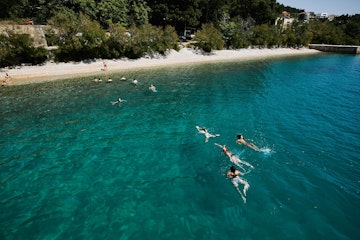
Blače
Only a 20 minute walk from Saplunara, in Limuni Bay, you’ll stumble across the sandy oasis known as Blače. This hidden, lagoon-shaped bay is funnily enough the largest sandy beach on the island and yet remains relatively secluded - perfect for those searching for peaceful solitude. Just outside of the National Park, Blače is accessible by a narrow dirt road from Saplunara in which case your best means of transport is walking or renting a scooter. Pass the time playing picigin, catching up on your current read, or snorkel your way through the fresh water at this stunning stop!
Mljet is an untouched piece of Croatian heritage that is a melodious attraction to travellers. It’s not hard to see why visitors fall in love with this gem! Filled with ancient history, a protected park, and unfathomable beauty, it’s a destination that will stay with you forever.


